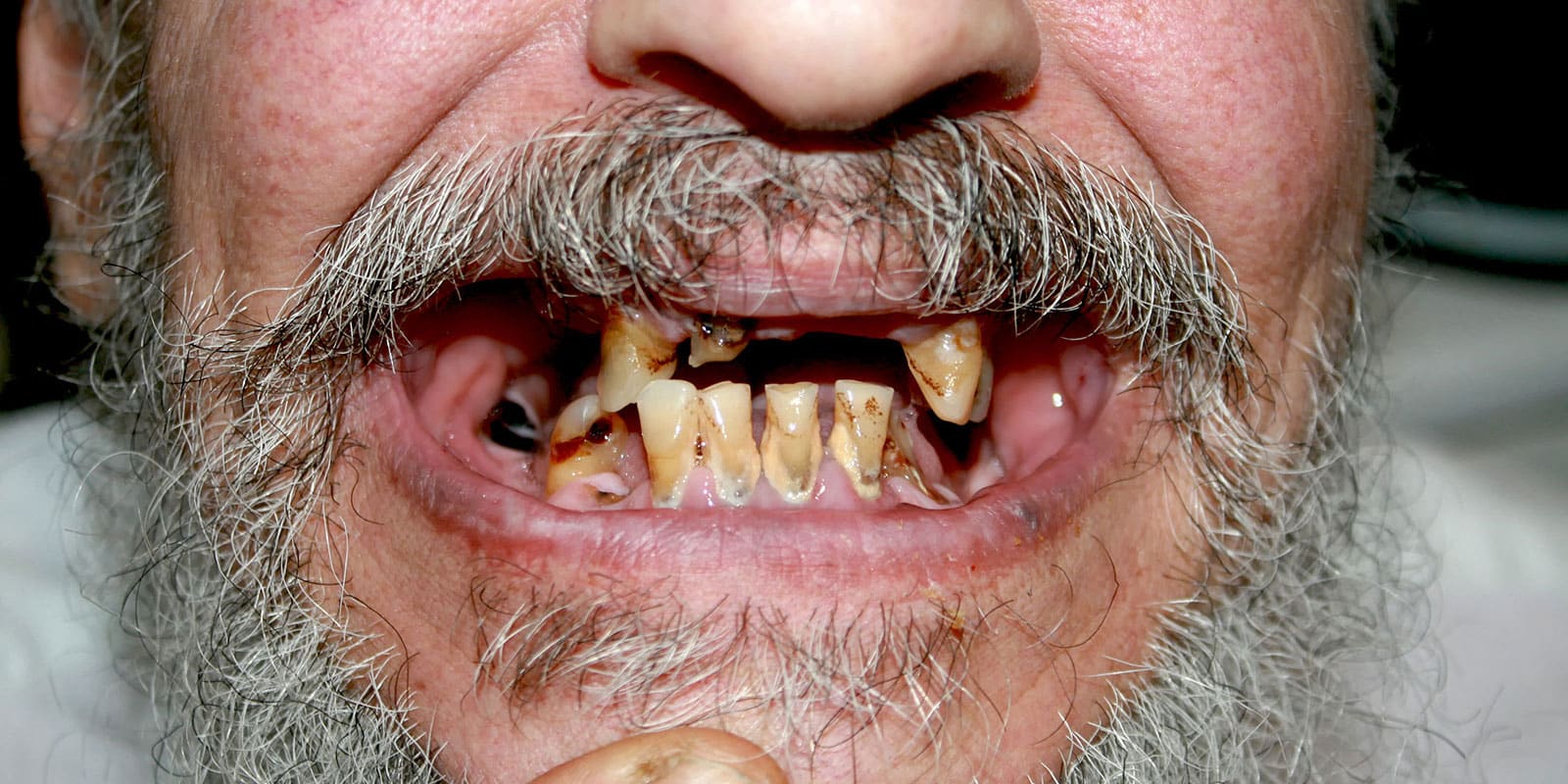Table of Contents
What Is Meth Mouth?
Meth mouth is a serious dental condition that causes gum disease and severe tooth decay. These conditions can cause you to lose your teeth, or they can make them break off. Dentists gave 571 users of meth dental examinations, and they learned that 31% of them were missing at least six or more teeth and that 96% had cavities.
The description of a methamphetamine user’s teeth includes teeth that are stained or blackened as well as teeth that are crumbling and rotting. In many instances, dentists cannot salvage these teeth, and they must extract them.
Meth mouth occurs in the following three stages:
Stage One
The front teeth begin to decay first. The meth user begins to experience bad breath and red, swollen gums. The teeth eventually begin to decay.
Stage Two
The gums start to recede, and the person’s lips begin to develop sores. Tooth decay gets even worse at this point.
Stage Three
Tooth decay reaches the person’s gumline. This is also when the person starts to lose his or her teeth. According to the American Dental Association, if a person’s teeth haven’t fallen out at this point, they will need to be removed.
Other signs of meth mouth include micro-cavities, lockjaw, cracked, loose or missing teeth, and dry mouth. Meth users also grind or clench their teeth.
What Is the Cause of Meth Mouth?
One reason that people experience meth mouth is because their dental hygiene begins to suffer while they are in the throes of an addiction. The addiction also leads to poor nutrition and the lack of regular dental care. Meth users often forget to brush their teeth, and they may also eat sweet foods while they are using. As a matter of fact, eating sweets and drinking sodas is known as “buzzing” in the meth community, and this activity damages the enamel of their teeth even further.
The act of eating sugary foods and smoking methamphetamine is a major cause of tooth decay. When cavities are left untreated, it can cause nerve damage, abscesses in the mouth and damage to the teeth.
When people are addicted to methamphetamine, their focus is on obtaining their drugs and not on maintaining their dental hygiene. They may not be consuming enough vitamin C and iron, so their bodies cannot heal themselves as well as when they were consuming sufficient amounts of these nutrients. If they develop abscesses or lesions, they can be extremely painful because their bodies cannot help them heal.
When methamphetamine users are high, they often grind their teeth, and this causes them to chip. In addition to that, meth is very acidic, so it weakens teeth and causes them to easily crack and break. Meth also contains several dangerous chemicals, including lantern fluid, antifreeze, drain cleaner and battery acid, and these chemicals contribute to the erosion of bodily tissues. These additives were not meant for human consumption.
Meth mouth also causes severe dry mouth that is known as “Xerostomia.” This occurs because meth dries the salivary glands of a meth user’s mouth. When this happens, bacteria are allowed to flourish in the mouth, and the user’s teeth begin to rot, and the gums begin to decay.
How Else Does Meth Affect Your Health?
Meth mouth can damage more than just your mouth; it can affect your entire body in the following ways:
- Itching that is caused by sensitivity of the nerves
- Brain damage
- Stroke
- Lead poisoning
- Risk of hepatitis and HIV
- Heart issues
- Convulsions
- Hyperthermia
- Premature delivery
Treatment for Meth Mouth
Unfortunately, the treatment for meth mouth is often tooth extraction, but sometimes, dentists can treat some of the issues that meth mouth causes. Dental treatment does not end the treatment for methamphetamine use. A methamphetamine use disorder must be treated in a substance use treatment center. At Long Island Addiction Treatment Center, we can treat you or your loved one for an addiction to methamphetamine.
The first step in treating an addiction to methamphetamine is the “detoxification process.” The Drug Enforcement Administration placed methamphetamine in Schedule IIN on the list of Controlled Substances. This means that it is a stimulant that has a high potential to be abused by users and can lead to a severe psychological or physical dependence. Therefore, you or your loved one will need to undergo the detoxification process before we can treat you for your psychological dependence.
To begin treatment, we must remove all traces of methamphetamine from your body, but you must stop ingesting the substance first. Because methamphetamine causes you to experience highly unpleasant withdrawal symptoms if you fail to take your daily dose of the drug, our staff may administer medications that will help you tolerate the absence of the drug during the detoxification process. Then, your body can slowly adjust to the lack of methamphetamine in your system.
Methamphetamine Withdrawal Symptoms
Short-term withdrawal symptoms that last for approximately two weeks include the following:
- Insomnia
- Anxiety
- Fatigue
- Psychosis
- Intense cravings
- Appetite changes
- Muscle spasms and pain
- Headaches
- Dehydration
Long-term withdrawal symptoms include the following:
- Cognitive issues
- Anxiety
- Cravings
- Irregular sleep
- Depression
In the detoxification stage, you will learn how to manage your cravings, and you will also learn how to avoid returning to drug use. After the detoxification process is over, we will place you or your loved one in therapy that addresses your psychological addiction to methamphetamine.
Therapy is necessary because a substance use disorder is about more than just a physical addiction to a drug. After the detox process is over and you aren’t physically dependent on methamphetamine, you will still be at risk of relapsing. That’s because you will experience several triggers that may lead you back to methamphetamine use. For example, you may continue to spend time with other methamphetamine users. Places you used to go while you were using the substance may also lead you to crave the drug again. Lastly, sudden life stress can cause you to want to ease the pain with methamphetamine use again. You aren’t experiencing strong cravings or withdrawal symptoms, but the triggers listed above can continue to push you in the direction of methamphetamine use.
As you get counseling for your substance use disorder, you will learn how to manage your cravings and live your life without the need to self-medicate with substances.
Types of Therapy for the Treatment of Substance Use Disorders
Group Therapy
Group therapy is highly effective for the treatment of substance use disorders. In group therapy, your peers will be available to challenge you when you need to be challenged and support you when you need the support. They will be experiencing the exact same things that you will be, so they are the most appropriate people to perform these actions for you.
Individual Therapy
Individual therapy is also very necessary because you will have your own therapist, and you will meet with him or her in one-on-one sessions. This allows you to address issues that you aren’t comfortable introducing in a group session. It is also particularly useful if you are experiencing a mental health disorder along with your substance use disorder. Both of these conditions need to be treated at the same time so that you can overcome each without neglecting one.
Partial Hospitalization Program
If you or your loved one are dedicated to sobriety, the partial hospitalization program may be right for you. It is recommended for people with a strong support system because it is a program that allows you to live at home while you are in treatment. However, you must be in a drug-free environment to take advantage of the program.
Intensive Outpatient Treatment Program
If you are experiencing a mental health condition, you will be placed in the intensive outpatient treatment program. This program will be for you or your loved one if you are diagnosed with an eating disorder, anxiety disorder, depressive disorder, bipolar disorder and a substance use disorder. You can engage in this program if you no longer need to remain in an inpatient program and would like to continue your treatment before you step back into your old life again. You must be in a safe environment with supportive family members to take advantage of this option.
Outpatient Treatment Program
The outpatient treatment program gives you the option of continuing your treatment after an inpatient program, but it also allows you to remain in your job and live at home. This level of treatment teaches you to manage your substance use disorder over the long term, and you may only need to attend therapy sessions three times per week. It is an option for someone with a mild addiction, but it can also be a program that you choose for yourself or for a loved one after inpatient therapy. In most cases, sessions are held at night so that you can continue to go to work or attend school.
Outpatient treatment is advantageous because it can provide family therapy for you and your family members. This isn’t always the case with inpatient programs. It gives your family members the chance to be your support, but it also gives them the opportunity to learn about the behaviors that you may engage in because of substances as well as the medical and psychological consequences of being addicted to a substance.
If you or a loved one need help with a methamphetamine addiction, contact us today at Long Island Treatment Center.
FAQ
How do I know if I have meth mouth?
What is the medical term for meth mouth?


